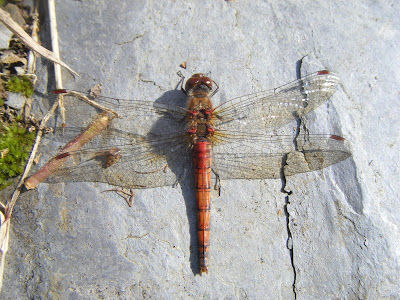 |
| Male Common Darter, Sympetrum striolatum |
The Common Darter (Sympetrum striolatum) is, as its name suggests, a common and widespread dragonfly in Ireland, indeed in Europe as a whole. Flying between June and October, it can often seen resting on paths or stones in sunny, open areas. S. striolatum is a very aggressive, territorial species and will “dart” at other, often larger dragonfly species. Males and females differ in their colouring, with mature males having orange-red, unwaisted abdomens in contrast to the the dull, yellow-brown females.
 |
| Female Common Darter, Sympetrum striolatum |
Individuals are most often seen near favoured breeding sites of shallow ponds and small lakes, so it was therefore a surprise when in Hungry S. striolatum (along with five other species of Sympetrum) individuals were observed in large numbers in a cemetery that was nowhere near any water source (1). Were they just being spooky or was there a more rational answer?
 |
| Common Darter, Sympetrum striolatum |
The dragonflies were seemingly attracted to polished black gravestones, where their behaviour was the same as if by water. This involved perching near the gravestones and defending their perch, flying individuals repeatedly touching the gravestone surfaces with their ventral sides and pairs in tandem position frequently circling over the gravestones. It was found that the gravestones reflect highly and horizontally polarised light in a manner almost identical to smooth water. S. striolatum, along with many other dragonfly species, find their aquatic habitats by means of polarotaxis, the use of reflected polarised light to discriminate between surfaces (2). This explains the attraction to the gravestones, an attraction that is so strong that females are sometimes lead to oviposit on the gravestones.
References:
- Horváth et al., 2007. Freshwater Biology 52 pp. 1700–1709
- Bernáth et al., 2002. Freshwater Biology 47 pp. 1707–1719
No comments:
Post a Comment